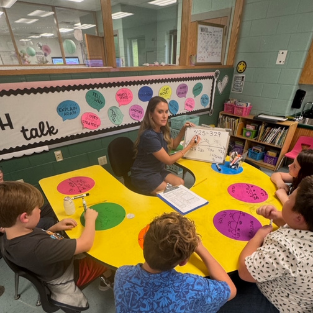Teachers Enable Vibrant Learning
September 4, 2025
Teachers Enable Vibrant Learning
At the heart of every vibrant learning experience is a strong teacher. A great educator transforms content into curiosity, and classrooms into spaces where students feel both challenged and supported. When we talk about building a future-ready public education system in Kentucky, the starting point is clear: we must ensure a great teacher is present in every classroom.
Kentucky’s school leaders have worked diligently to raise teacher pay in recent years. In fact, many districts have given some of the largest percentage raises in their history, and those efforts have largely kept pace with inflation. But keeping up is not the same as catching up. Teachers have not regained the ground lost during the lean years following the 2008 recession, when salaries failed to keep pace with rising costs. At the same time, private sector wages have surged ahead, widening the pay gap and making it harder to recruit and retain the next generation of educators.
We cannot rob Peter to pay Paul. Long-term commitments such as pensions, health care, and retirement security are essential for stability in the profession. At the same time, year-to-year funding for salaries and classroom resources determines whether teachers feel valued and whether districts can attract the next generation of talent. Both elements matter. Both must be sustained.
Teachers are not asking for luxuries; they are asking for the conditions that make vibrant learning possible. Competitive salaries, reliable benefits, and supportive working environments ensure Kentucky classrooms remain staffed with the kind of educators who bring lessons to life. Without these, we risk losing teachers to other professions or neighboring states, which is an outcome Kentucky cannot afford.
This is why our legislative advocacy must stay focused on both sides of the equation. Investing in SEEK funding, protecting retirement systems, and ensuring sustainable pathways for compensation are not abstract policy debates. They are the concrete decisions that determine whether every Kentucky child has access to a strong teacher, every single year.
As superintendents, we know the stakes. When teachers thrive, students thrive. Vibrant learning is not a slogan; it is the daily work happening in classrooms across the Commonwealth. Let us continue to lead with purpose, advocate with unity, and put Kids First by ensuring that Kentucky teachers have the respect, resources, and rewards they deserve.

Strong schools are built on strong leadership. Across Kentucky, superintendents understand that thriving classrooms and successful districts depend on more than one leader at the top. They rely on principals, assistant principals, teacher-leaders, instructional coaches, and district staff who share responsibility for shaping the future of public education. At KASS, we believe that every district deserves a great superintendent, every school deserves a great principal, and every classroom deserves a great teacher. None of that happens by accident. Leadership Development: The Foundation of Strong Schools Recent statewide data affirms what local leaders see every day: leadership pipelines matter. When schools intentionally invest in developing leadership capacity, they cultivate innovation, stability, and long-term success. These pipelines ensure that when experienced leaders retire or change roles, a new generation is prepared to step forward with skill and vision. As KDE continues expanding professional learning and leadership pathways, the message is clear: leadership development is not a luxury—it is essential. Kentucky schools are meeting rising expectations related to mental health, school safety, family engagement, career readiness, and personalized learning. Meeting these demands requires a deep bench of capable, well-supported leaders. Leadership Pipelines: Essential, Not Optional Investing in leadership pipelines means creating systems that identify, mentor, and prepare future school leaders. These systems help districts: Identify teachers with leadership potential Provide targeted coaching and mentoring Offer professional development aligned with district goals The Wallace Foundation reports that school leadership is second only to classroom instruction in its influence on student achievement. Kentucky districts that invest in structured pipelines are creating the conditions for sustained excellence. But leadership development in Kentucky is not limited to adults. Increasingly, schools recognize that student leadership is essential to student success . Whether through student voice initiatives, service learning, or Portraits of a Learner that emphasize collaboration, initiative, and agency, schools are intentionally cultivating leadership in young people. As I often reminded my own leadership teams, if students aren’t in on it, our efforts will fall short of their intended impact. When we invest in strong adult leadership pipelines, we make possible equally strong student leadership pipelines—ensuring that learners graduate empowered, engaged, and ready to lead in their communities and careers. Aligning with Kentucky’s Education Priorities KASS has long emphasized that education leadership is a workforce priority. The 2026 KASS Legislative Priorities reinforce this message through policies that support educator recruitment, retention, and leadership development—broadening certification options, expanding job-embedded professional learning, and strengthening grow-your-own initiatives such as Educators Rising. Just as importantly, KASS advocates for reducing unnecessary bureaucratic burdens on schools so leaders can focus on students, not paperwork. Some have argued that districts are growing administrative staff unnecessarily. In reality, the expansion of district-level responsibilities is a direct response to state and federal mandates —most of them well intentioned, but increasingly complex. These requirements lean heavily toward compliance rather than engagement, empowerment, or student impact, and they come with extensive reporting, monitoring, and oversight obligations. When laws are passed quickly, without full consideration of the operational impact, they can create wide-ranging, unintended consequences—especially when they are underfunded or unfunded. These mandates directly shape district staffing patterns, making administrative support a necessity rather than a choice. If Kentucky wants leaner bureaucracy, the solution is not to cut people who are required to carry out legally mandated tasks—it is to r eview and streamline the mandates themselves so schools can redirect time, resources, and talent back into developing strong leaders at every level. This vision aligns directly with United We Learn , which calls on Kentucky to rethink accountability and build systems that empower, rather than constrain, educators and local communities. Investing in People for Student Success Leadership pipelines strengthen the teaching profession and improve outcomes for every learner. Research from the National Bureau of Economic Research shows that schools led by effective principals see higher teacher retention and stronger student performance. And when adult leaders focus on empowering students, the impact multiplies. Schools with strong leadership cultures give students more opportunities to practice agency, take initiative, and develop the skills emphasized in Kentucky’s Portrait of a Learner. KASS continues to advocate for legislative funding that prioritizes people over programs. Districts need flexibility and resources to provide competitive salaries, mentoring programs, and professional learning communities that elevate educators at every stage of their careers—and, in turn, elevate the leadership pathways available to students. A Shared Vision for the Future For Kentucky’s superintendents, this work is both urgent and hopeful. Leadership development provides stability during times of change and momentum during times of challenge. Across the Commonwealth, superintendents are cultivating a culture of mentorship, collaboration, and lifelong learning that benefits every student. By strengthening Kentucky’s leadership pipeline—both for adults and for students—we ensure that every child learns in a school led by compassionate, highly skilled professionals committed to keeping Kids First . That is how we build a stronger, more resilient future for Kentucky’s public schools.

Nestled in the hills of Eastern Kentucky, Morgan County Schools stands as a powerful example of what happens when vision, community, and legislative support come together to serve every student. With around 1,600 students across six schools, the district is small in size but large in heart—driven by a deep belief that every child deserves the opportunity to thrive. Through the implementation of a Multi-Tiered System of Supports (MTSS), Morgan County is not only improving academic outcomes but also redefining what equitable learning looks like in rural education. This work is made possible through targeted state and federal investments, including increased SEEK and Tier I funding and legislative support for the Read to Succeed and Numeracy Counts Act. A Community Rooted in Resilience and Hope Morgan County’s story begins with a tradition of strength and resilience. In a region where many families face economic hardship, the schools have become the heartbeat of the community—a place where hope is cultivated and opportunity takes root. Superintendent Dr. Ralph W. Hamilton and his leadership team understand that rural districts must often do more with less. Legislative resources have provided essential flexibility—allowing Morgan County to prioritize “people over programs,” attract and retain talented educators, and align instruction to the unique needs of their students. This emphasis on local priorities reflects the broader goals of the Kentucky Association of School Superintendents (KASS) 2026 Legislative Agenda, which calls for closing the SEEK funding shortfall, improving school construction funding, and strengthening the educator pipeline. Morgan County’s work exemplifies how these priorities can come to life at the district level. What MTSS Means for Students MTSS is a proactive, evidence-based approach that helps schools meet students where they are—academically, behaviorally, and emotionally. In Morgan County, the model is built around three tiers of support: Tier I: Universal instruction that serves over 80% of students through high-quality, grade-level teaching and schoolwide supports. Tier II: Targeted interventions for roughly 15% of students who need additional help in specific skill areas. Tier III: Intensive, individualized interventions for the 5% of students who require specialized, sustained support. This system ensures that learning is fluid and responsive. Teachers regularly review data to identify student needs, adjust instruction, and collaborate across grade levels. The goal is not just to improve test scores—but to create confident, independent learners prepared to succeed in life beyond the classroom. The Power of Partnership The success of MTSS in Morgan County is not solely the result of internal strategy—it’s the outcome of partnerships that span the entire community. Local businesses provide mentorships and work-based learning experiences that give students real-world perspective. Community organizations play a vital role in social-emotional learning (SEL) and family engagement, while nearby higher education institutions open doors to advanced coursework and career pathways. These connections extend the classroom into the community, reflecting one of KASS’s core advocacy goals: empowering local districts to collaborate for sustainable, community-centered learning. Results That Speak for Themselves Morgan County’s investment in MTSS is already producing measurable and meaningful results: Improved academic performance on both state and local assessments. Consistently high graduation rates that reflect a culture of persistence. Decreased behavioral referrals, signaling stronger student engagement. Higher attendance rates, often linked to the sense of belonging cultivated in supportive classrooms. Teachers report increased positive behavior, engagement, and collaboration among students. Through targeted interventions and small-group instruction, students build confidence and master challenging content. The district’s commitment to holistic education is embodied in its Portrait of a Learner—encouraging each child to grow as an Impactful Citizen, Confident Contributor, Empathetic Servant, Solution Seeker, and Effective Communicator. Celebrating Excellence and Recognition Morgan County’s schools are no strangers to recognition. Ezel Elementary has twice been named a National Blue Ribbon School. East Valley Elementary earned the same distinction once and ranked among the top ten schools statewide in 2024 performance on the Kentucky Summative Assessment. All six district schools—East Valley, Ezel, Morgan Central, Wrigley Elementary, Morgan County Middle, and Morgan County High—have been recognized as Prichard Committee Family Friendly Schools. These achievements represent far more than accolades; they are evidence of a district culture built on collaboration, equity, and continuous improvement. Legislative Support: A Lifeline for Rural Opportunity Morgan County’s success is directly tied to strong legislative partnerships and advocacy for equitable funding. Increased SEEK and Tier I funding has allowed the district to recruit and retain high-quality educators, improve compensation, and sustain critical programs that larger districts often take for granted. This aligns closely with KASS’s call to close the SEEK shortfall and ensure that Kentucky’s funding formula provides a fair opportunity for all students, regardless of zip code. Similarly, continued investment in the Read to Succeed and Numeracy Counts Act helps ensure that foundational literacy and numeracy skills are supported from the earliest grades—an essential step toward fulfilling the United We Learn framework’s vision for lifelong learning. Looking Ahead: Sustaining the Momentum For Morgan County Schools, MTSS is not a one-time initiative—it’s an ongoing process of reflection, collaboration, and growth. As the district continues to build capacity, expand professional learning, and engage families, it serves as a model for how Kentucky’s rural districts can deliver innovation with limited resources. Dr. Hamilton notes that the district’s greatest strength lies in its people: “When we prioritize people over programs, we build a system where every student—and every educator—can succeed.” This mindset perfectly captures KASS’s vision for Kentucky’s future: a united, learner-centered system where every child, regardless of background, has the tools to succeed. Why This Matters for Kentucky’s Future The lessons from Morgan County are clear: Legislative investments in equity yield transformative outcomes. Supporting educators drives systemic improvement. Collaboration among schools, families, and communities creates sustainable success. As Kentucky continues to build on the United We Learn vision, districts like Morgan County demonstrate what’s possible when funding, flexibility, and local leadership align. Their story proves that even in the most rural corners of the Commonwealth, the pursuit of excellence knows no limits. Join the Movement Learn more about Morgan County Schools’ work by following Morgan County Schools on Facebook or @SuptMCS on X. Together, we’re shaping the future of Kentucky’s public education—one student, one school, and one strong community at a time.

Accountability in Kentucky’s public education system is strongest when it reflects the voices and values of local communities along with statewide priorities for reading, math, transition readiness, graduation, student growth and grade-level performance. Across the Commonwealth, districts are demonstrating how local innovation, data transparency, and community collaboration can transform how we define student success. By elevating both metrics and meaning, superintendents are building systems that not only meet state standards but also reflect the priorities of Kentucky families, educators, and students. Reimagining Accountability through Local Voices Kentucky’s approach to accountability has long emphasized state assessment results and compliance metrics. But superintendents across the state are asking an essential question: What if our accountability systems measured what matters most to our communities? Districts like Kenton County, Fleming County, and Bullitt County are answering that call by building community-facing dashboards that align state-required data with locally meaningful measures. These dashboards showcase not just test scores, but also indicators like career readiness, student well-being, and authentic learning experiences. Kenton County Schools has created an online dashboard that pairs academic results with student wellness data and career readiness outcomes, giving families a more holistic understanding of progress. Fleming County Schools has built an interactive Portrait of a Graduate Dashboard that tracks academic growth, career readiness, and community engagement in real time. This local system reflects the district’s vision for transparent, community-centered accountability. Bullitt County Schools has reimagined communication by sharing stories of teachers and students who embody the district’s goals, turning abstract data into relatable narratives. Other districts, including Greenup, Shelby, and Butler counties, are also piloting new models that blend data, transparency, and storytelling, proving that accountability goes beyond compliance, focusing on clarity, connection and meaningful experiences. Accountability as a Partnership At its core, accountability should not be something done to schools; it should be built with schools and communities. Families want to see how their schools are preparing students for the future, but they also want evidence that reflects their own local priorities. Dashboards that visualize data on career pathways, student engagement, and community service create a shared language of progress. When a district superintendent pairs a rising graduation rate with a student’s career pathway story, accountability becomes more than a number. It becomes a narrative of growth and opportunity. Connecting Local Innovation to Statewide Vision This movement toward locally aligned accountability directly supports the 2026 KASS Legislative Priorities, particularly the goal to “Launching a meaningful and modern education accountability system” The United We Learn initiative, led by the Kentucky Department of Education (KDE), envisions an education system rooted in equity, innovation, and deeper learning. It calls for locally developed accountability structures that balance state oversight with the flexibility districts need to measure what matters most. KASS has elevated superintendents voices in the development of this vision. Our association believes that district-driven accountability (guided by community voices and informed by real-world data) is essential to preparing students for lifelong learning and success. As part of its 2026 advocacy platform, KASS continues to champion policies that: Empower districts to use authentic, locally developed measures of learning and growth. Encourage innovation in how schools report performance to families and communities. Support professional learning for superintendents and educators to implement next-generation accountability models. Provide the flexibility in the system to reflect the unique needs and opportunities of each community. Local Metrics in Action: From Data to Story When data tells a story, communities engage. That’s the lesson coming from districts like Kenton and Fleming counties. Instead of publishing charts filled with unfamiliar terms, these districts are using interactive dashboards and story maps to bring numbers to life. For example, a dashboard may show how many students completed dual credit courses, but it might also feature a short video of a student explaining how that course prepared them for college or a career in healthcare. This blend of quantitative and qualitative reporting is reshaping how stakeholders perceive accountability. It’s not just about performance indicators; it’s about understanding impact. Moreover, these approaches promote trust and transparency, which are key pillars in public education. Research from the National School Public Relations Association emphasizes that storytelling paired with data enhances community confidence and fosters long-term engagement. Kentucky districts are proving this to be true. Building Capacity for the Future KASS recognizes that building local accountability systems requires both resources and professional support. That’s why our 2026 legislative priorities include continued investment in educator development, particularly around data/assessment literacy and local communication strategies. Superintendents must be equipped to lead not only instructional change but also narrative change by helping their communities understand what modern education success looks like. By aligning accountability with career readiness pathways, numeracy and literacy goals, and authentic learning experiences, districts ensure that local innovation complements statewide progress. This work also ties to KASS’ long-term focus on education funding reform, ensuring that districts have the flexibility to direct resources toward initiatives that support locally defined outcomes. A Kids First Approach to Accountability Every element of this new accountability vision circles back to the KASS mission: putting Kids First. When schools measure what truly matters (student engagement, well-being, and preparedness) they reinforce the belief that accountability should serve students, over systems. The shift toward local metrics ensures that the measures of success are as diverse as the communities they represent. As KASS Executive Director Dr. Jim Flynn often reminds us, “Accountability is about strengthening how we practice and grow, as much as proving performance and impact.” This mindset empowers districts to take ownership of their data and design models that celebrate both progress and potential. Looking Ahead: Accountability as a Living Practice Kentucky’s superintendents are leading the way toward a more meaningful accountability future. They know that one-size-fits-all models cannot capture the diverse strengths of Kentucky’s school districts. By elevating local voices and local metrics, we are shaping a system that measures not only student achievement but also the relationships, creativity, and resilience that define lifelong learning. This work isn’t a moment in time; it’s a movement taking shape. As Kentucky continues to innovate under the inspiration of the United We Learn vision, KASS remains committed to advocating for policies that amplifies superintendent voices and builds traction for sustained progress into 2026 and beyond.

Preschool is more than a stepping stone to kindergarten. It represents a critical investment in Kentucky’s children, families, and communities. Decades of research confirms that high-quality early learning experiences yield lifelong academic, social, and economic benefits. For the Commonwealth, expanding access to preschool is more than an educational goal; it represents both a moral and an economic imperative. Laying the Foundation for Lifelong Success Children’s earliest years are marked by rapid brain development. According to the Harvard Center on the Developing Child, more than one million new neural connections form every second during the first few years of life. These connections shape how children learn, interact, and problem-solve throughout their lives. When children attend high-quality preschool programs, they build foundational skills (language, emotional regulation, curiosity, and cooperation) that are directly linked to later academic and career success ( Harvard University, 2023 ). For children from low-income families or those with disabilities, early access to structured learning opportunities can be transformative. A longitudinal study by the National Institute for Early Education Research (NIEER) found that students who attended high-quality preschool were more likely to graduate from high school, pursue higher education, and earn higher wages as adults ( NIEER, 2022 ). By investing in early education, Kentucky can narrow opportunity gaps before they widen. Strengthening Families and Supporting the Workforce Preschool access goes beyond education; it’s also essential to building a strong workforce. Families need reliable, affordable childcare to fully participate in the economy. The U.S. Chamber of Commerce Foundation estimates that Kentucky loses over $2 billion annually in economic activity due to childcare-related workforce disruptions ( U.S. Chamber Foundation, 2023 ). When parents have confidence that their children are safe, supported, and learning, they can focus on their careers and contribute more productively to the workforce. This connection between early education and workforce stability underscores the importance of viewing preschool as infrastructure, equally essential to roads, broadband, and utilities. Expanding preschool access strengthens Kentucky’s labor participation rates and builds a stronger foundation for future economic growth. A Smart Investment with Lasting Returns For every dollar invested in high-quality early childhood programs, society sees a return of up to $7 through improved educational outcomes, increased earnings, and reduced social costs, according to Nobel laureate economist James Heckman ( Heckman, 2022 ). The long-term benefits ripple across generations: higher graduation rates, lower crime rates, better health outcomes, and stronger communities. These outcomes make preschool a rare policy area that enjoys bipartisan support. Across Kentucky, leaders from every political perspective recognize the value of investing in children’s earliest years. When we put Kids First, we build stronger schools, stronger families, and a stronger Commonwealth. Models of Collaboration Across Kentucky Kentucky already has strong models demonstrating how collaboration can expand early learning opportunities. Across the state, public schools and private childcare providers have partnered to create blended preschool programs that reach more children while maintaining high quality standards. The Prichard Committee for Academic Excellence and the Kentucky Department of Education have led initiatives (such as community schools and literacy grants) that show how shared responsibility can produce meaningful results. These partnerships serve as a blueprint for scaling success. By bringing together local districts, community organizations, parents/families, and private partners, Kentucky can ensure that every child, regardless of zip code or income, begins their educational journey with confidence. Policy Leadership and the Path Forward Superintendents play a critical role in advancing preschool access. As education leaders, they understand that early learning investment affects not only classroom readiness but also community vitality. KASS advocates for policy solutions that ensure stable funding, equitable access, and quality standards across all early learning programs. Key policy actions include: Expanding state funding for preschool programs, particularly in underserved areas. Supporting mixed-delivery models that allow public schools and private providers to collaborate effectively. Improving educator pay and professional development to recruit and retain high-quality preschool teachers. Streamlining regulations to remove barriers that prevent families from accessing programs easily. These actions align with KASS’s 2026 legislative priorities, which emphasize purposeful advocacy and proactive solutions to improve Kentucky’s public education system. Economic and Community Impact When preschool participation increases, communities thrive. Parents remain in the workforce, local businesses experience greater stability, and children enter kindergarten ready to learn. Studies from the Federal Reserve Bank of Minneapolis show that communities investing in early learning see higher employment rates, stronger tax bases, and reduced dependency on social services ( Federal Reserve Bank of Minneapolis, 2021 ). For rural areas, where workforce participation and childcare availability often lag, these investments are particularly crucial. Kentucky’s rural communities, like those in Eastern and Western Kentucky, stand to gain the most from expanded preschool access, both socially and economically. Voices from the Field Superintendents across the Commonwealth echo a common theme: preschool investment is an investment in Kentucky’s future. They witness firsthand how early learning changes lives. As one superintendent recently shared, “When children arrive in kindergarten ready to learn, everything changes, from classroom engagement to long-term academic success. The impact is immediate and enduring.” Local partnerships also reveal how preschool builds stronger family-school connections. Parents involved in early learning programs are more likely to stay engaged throughout their child’s education, fostering a culture of collaboration between home and school. That engagement creates a ripple effect: students thrive academically, and schools become more responsive to community needs. Putting Kids First At KASS, our guiding principle is simple: When we put Kids First, everyone wins. Preschool is not an expense to be debated; it’s a commitment to the future of Kentucky’s children and the prosperity of our Commonwealth. By expanding access to high-quality preschool, we give every child the chance to reach their full potential, every family the opportunity to participate in the workforce, and every community the tools to grow stronger together. Investing in preschool is more than smart policy; it’s a promise to our future.

Building the Workforce Kentucky’s Students Deserve Across the Commonwealth, superintendents are confronting the same challenge: how to attract and keep the high-quality educators and staff every student deserves. Compensation matters, but as Kentucky’s education leaders know, it is not sufficient on its own. Building a durable education workforce requires clearing certification bottlenecks, aligning professional learning to the real work of teaching, reducing outdated mandates, and empowering local accountability grounded in United We Learn . KASS’s 2026 priorities point the way forward: recruit and retain high-quality teachers and staff, study and remove outdated mandates, and build momentum for an accountability system aligned to United We Learn, a model that supports innovation and meaningful measures of student learning. The Workforce Reality: Vacancies, Turnover, and Competition for Talent Recent data from the Kentucky Department of Education’s 2023–24 Educator Shortage Report show that 13 percent of all posted vacancies remained unfilled for the entire school year, and districts reported 1,766 classified support staff vacancies as of September 1. These positions are vital to student learning and daily operations. Turnover is equally costly. According to the Learning Policy Institute , teacher turnover, which includes costs for separation, recruitment, and onboarding, averages between $12,000 and $25,000 per teacher depending on district size. High turnover drains resources that could otherwise support classrooms and is linked to lower student achievement. Kentucky cannot simply hire its way out of the challenge. The state must compete for talent by making it easier for educators to enter, remain, and grow in the profession. Certification Reform: Widening the Gate Without Lowering the Bar One of the most significant barriers to building Kentucky’s teacher workforce lies in certification. For decades, certification structures have been rigid, with limited flexibility for individuals who bring valuable experience into the classroom. Kentucky has taken meaningful steps to address this issue. In June 2025, the Education Professional Standards Board (EPSB) reviewed recommendations from its Certification Structure Workgroup to modernize grade bands and expand flexible pathways. These proposals include multiple ways to demonstrate competency, broader grade-band options such as K–8 or 6–12, and smoother entry routes for experienced professionals, particularly in high-need secondary and career and technical education fields. There are particular high needs areas in Kentucky. Almost every district across the state has experienced certification issues related to secondary math and science positions. Recommendations like general science certifications for 6-12 can help attract potential educators and free up certification quandaries at the secondary level. Currently, unlike say English, where a teacher could teach any of the grade levels in that content, science has highly specific degrees that require not just a science credential, but biology, or chemistry, or physics. The legislature can ensure all stakeholders are brought together to address these types of challenges. Reforming certification does not mean lowering standards. It means removing barriers that keep capable people out while maintaining high expectations that protect students and the profession. Professional Learning That Works: Job-Embedded, Ongoing, and Focused Recruitment without retention is a revolving door. Research shows that sustained, job-embedded professional learning improves both teaching practice and student outcomes. KASS’s 2026 priorities call for aligning professional development requirements with educator contracts to emphasize personalized, job-embedded learning. That alignment shows respect for educators’ time and ensures that professional learning translates into stronger instruction. Many districts have created wonderful models of this by taking advantage of flexible calendars, instructional coaches, and federal funding. We must ensure those are highlighted and we continue to create these opportunities for teachers across the commonwealth. When our schools dedicate time for coaching, professional learning communities, and curriculum-aligned professional development, we treat teacher learning as essential infrastructure, not a compliance task. By giving them a voice in this learning, we help retain teachers in the profession. Local Accountability and Local Empowerment Accountability frameworks shape how educators experience their work. When accountability emphasizes growth, authenticity, and community goals, teachers are more likely to stay and thrive. Kentucky’s United We Learn Council is developing a new accountability framework to present to legislators in 2026. The framework aims to capture the full breadth of student learning and opportunity, reflecting goals defined by local communities. Educators come to work everyday hoping to make a difference for students. This means ensuring essential learning goals but when this happens, what this looks like, and how we go about achieving it are nuanced. Local accountability gives us the opportunity to have a more holistic view of a student as well as the tireless work our educators do each day. This focus on local empowerment is central to KASS’s vision. Local accountability allows districts to design systems of growth rather than systems of punishment. As we continue building momentum for a unified accountability model that empowers districts to innovate for student success while maintaining clarity and comparability, we will attract and retain teachers to the profession. Strengthening the Pipeline: From Middle School to Master Teacher To compete for talent, Kentucky must inspire the next generation of educators long before they reach college. KASS supports expanding Educators Rising chapters in every middle and high school so students can explore teaching as a meaningful career path. Because most annual teacher demand results from attrition rather than new positions, retention is the most powerful workforce strategy. When early pipeline programs are paired with strong mentoring, induction, and leadership development, educators see a clear and lasting future within Kentucky schools. Cut the Red Tape: Let Educators Focus on Students Finally, superintendents across Kentucky report that overlapping mandates and reporting requirements create unnecessary burdens. Legislative and research briefings, including findings from the Kentucky Legislative Research Commission , have highlighted the need for modernization. Simplifying and streamlining these processes would return valuable time to teaching and leadership. KASS applauds recent legislative progress and supports continued collaboration with policymakers to ensure that reforms are practical, measurable, and sustainable. The Red Tape Reduction Act was a valuable first step in streamlining evaluation requirements and professional learning. There is still much work to do, however, particularly with legislative unfunded mandates, departmental interpretation of existing laws and regulations, and unleashing technology to allow schools to spend more time on student achievement and less time on burdensome bureaucratic initiatives. KASS is ready to work with our legislative partners to identify more opportunities to continue to cut red tape. A Call to Action KASS stands ready to partner with lawmakers, the EPSB, the Kentucky Department of Education, higher education, and local communities to recruit, retain, and elevate Kentucky’s education workforce. Together, we can ensure that every student learns from teachers and staff who are well-prepared, well-supported, and proud to call Kentucky home.

Nestled in the heart of Mercer County, Burgin Independent School stands as a model of what small schools can achieve when every student is known, valued, and empowered to lead. Serving approximately 530 students from preschool through 12th grade, the district continues a long legacy of community-driven education that dates back to its founding alongside the town of Burgin in the late 1800s. Under the leadership of Superintendent Chris LeMonds, Burgin Independent has embraced the power of connection—both within the classroom and across generations. One shining example is Burgin Family Day, a monthly, schoolwide initiative that brings together students from every grade level to build relationships, foster leadership, and strengthen the school’s family-like culture. Each month, a new theme—such as kindness, respect, or teamwork—guides activities that pair older and younger students for mentorship, collaborative learning, and fun. The results speak volumes. Since the program’s launch, 100% of students have participated each month, disciplinary referrals have declined, and teachers report stronger classroom relationships and improved morale. Parents echo that sentiment, often calling Burgin’s approach “a small school with a big heart.” One 10th grader shared, “I like Family Day because I get to spend time with younger kids and help them feel welcome,” while a second grader reflected, “The older students make me feel special because they spend time with me.” Legislative support has also played a key role in helping Burgin continue its mission. Through the recent increase in SEEK funding, the district is now hiring a full-time School Resource Officer (SRO)—a long-held priority that ensures every student learns in a safe and supportive environment. As Burgin Independent looks ahead, the district aims to expand Family Day to include community partnerships, parent engagement, and cross-curricular connections, continuing to model the power of unity and empathy in education.


